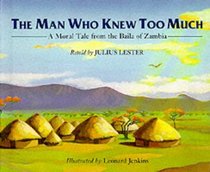Kate B. reviewed The Man Who Knew Too Much: A Moral Tale from the Baila of Zambia on + 46 more book reviews
Helpful Score: 1
From Publishers Weekly
As Jenkins's striking oil paintings evoke a beautiful green landscape flanked by purple mountains, Lester's severe story describes a woman who lays her child to sleep under a tree. When the child cries, a giant eagle swoops down onto the baby, quiets it and flies away without leaving even a scratch on the child's skin. The woman decides not to tell her husband about the marvel: "Sometimes we must guard what is inside us, refusing to share it with anyone." Finally, she confides in her husband, who doesn't believe her. She challenges him to hide in the bushes and watch. The man, seeing the bird descend on his child, shoots an arrow at it, but kills the child instead. "And that is how murder came into the world... because he thought he knew what he had never seen and never experienced." In a note at the end, Lester (To Be a Slave) presents the story as an "opportunity for adults to consider those times when a child has felt 'killed' when an adult did something that took away the child's sense of wonder and marvel in an experience." The conflicting messages of honesty, secrecy, knowledge, protection and belief make for a complicated stew-probably more than the target audience is ready for. Ages 5-8.
Copyright 1994 Reed Business Information, Inc.
As Jenkins's striking oil paintings evoke a beautiful green landscape flanked by purple mountains, Lester's severe story describes a woman who lays her child to sleep under a tree. When the child cries, a giant eagle swoops down onto the baby, quiets it and flies away without leaving even a scratch on the child's skin. The woman decides not to tell her husband about the marvel: "Sometimes we must guard what is inside us, refusing to share it with anyone." Finally, she confides in her husband, who doesn't believe her. She challenges him to hide in the bushes and watch. The man, seeing the bird descend on his child, shoots an arrow at it, but kills the child instead. "And that is how murder came into the world... because he thought he knew what he had never seen and never experienced." In a note at the end, Lester (To Be a Slave) presents the story as an "opportunity for adults to consider those times when a child has felt 'killed' when an adult did something that took away the child's sense of wonder and marvel in an experience." The conflicting messages of honesty, secrecy, knowledge, protection and belief make for a complicated stew-probably more than the target audience is ready for. Ages 5-8.
Copyright 1994 Reed Business Information, Inc.





